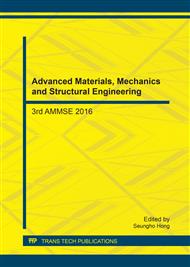[1]
R. Tremblay, Achieving a Stable Inelastic Seismic Response for Multi-Story Concentrically Braced Steel Frames, Eng. J. Second Quarter. 40(2) (2003) 111-129.
Google Scholar
[2]
R. Tremblay, S. Merzouq, Dual buckling restrained braced steel frames for enhanced seismic response, Proceedings, Passive Control Symposium, Yokohama, Japan, (2004).
Google Scholar
[3]
J. W. Lai, S. Mahin, Experimental and Analytical Studies on the Seismic Behavior of Conventional and Hybrid Braced Frames, PEER-2013/20, Pacific Earthquake Engineering Research Center, University of California, Berkeley, CA, (2013).
Google Scholar
[4]
I. F. Khatib, S. Mahin, K. S. Pister, Seismic Behavior of Concentrically Braced Frames, UCB/EERC-88/01, Earthquake Engineering Research Center, University of California, Berkeley, CA, (1988).
Google Scholar
[5]
J. W. Hu, Response of Seismically Isolated Steel Frame Buildings with Sustainable Lead-Rubber Bearing (LRB) Isolator Devices Subjected to Near-Fault (NF) Ground Motions. Sustain. 7 (2015) 111-137.
DOI: 10.3390/su7010111
Google Scholar
[6]
R. Sabelli, Research on Improving the Design and Analysis of Earthquake-Resistant Steel-Braced Frames, Earthquake Engineering Research Institute, PF2000-9, Oakland, CA, (2001).
Google Scholar
[7]
J. W. Hu, Investigation on the Cyclic Response of Superelastic Shape Memory Alloy (SMA) Slit Damper Devices Simulated by Quasi-Static Finite Element (FE) Analyses. Mater. 7 (2014) 1122-1141.
DOI: 10.3390/ma7021122
Google Scholar
[8]
L. Tirca, R. Tremblay, Influence of Building Height and Ground Motion Type on the Seismic Behavior of Zipper Concentrically Braced Steel Frames, Proceedings, 13th World Conference on Earthquake Engineering, Paper No. 2894, Vancouver, B.C., Canada, (2004).
Google Scholar
[9]
D. Mar, Design Examples Using Mode Shaping Spines for Frame and Wall Buildings, Proceedings, 9 th U.S. National and 10 th Canadian Conference on Earthquake Engineering, Paper No. 1400, Toronto, Canada, (2010).
Google Scholar
[10]
G. A. MacRae, Y. Kimura, C. W. Roeder, Effect of Column Stiffness on Braced Frame Seismic Behavior, J. Struct. Eng. ASCE, 130(3) (2003) 381-391.
DOI: 10.1061/(asce)0733-9445(2004)130:3(381)
Google Scholar
[11]
X. Ji, M. Kato, T. Wang, T. Hitaka, M. Nakashima, Effect of Gravity Columns on Mitigation of Drift Concentration for Braced Frames, J. Constr. Steel Res. 65(12) (2009) 2148-2156.
DOI: 10.1016/j.jcsr.2009.07.003
Google Scholar
[12]
A. Wada, Z. Qu, S. Motoyui, H. Sakata, Seismic Retrofit of Existing SRC Frames Using Rocking Walls and Steel Dampers, Front. Archit. Civ. Eng. China. 5(3) (2011) 259-266.
DOI: 10.1007/s11709-011-0114-x
Google Scholar
[13]
Z. Qu, A. Wada, S. Motoyui, H. Sakata, S. Kishiki, Pin-Supported Walls for Enhancing the Seismic Performance of Building Structures, Earthquake Eng. Struct. Dyn. 41(14) (2012) 2075-(2091).
DOI: 10.1002/eqe.2175
Google Scholar
[14]
C. H. Chen, S. Mahin, Performance-Based Seismic Demand Assessment of Concentrically Braced Steel Frame Buildings, PEER-2012/103, Pacific Earthquake Engineering Research Center, University of California, Berkeley, CA, (2012).
Google Scholar
[15]
P. Uriz, S. Mahin, Towards Earthquake Resistant Design of Concentrically Braced Steel Structures, PEER-2008/08, Pacific Earthquake Engineering Research Center, University of California, Berkeley, CA, (2008).
Google Scholar
[16]
F. McKenna, Object Oriented Finite Element Programming: Frameworks for Analysis. Algorithms and Parallel Computing, University of California, Berkeley, CA, (1997).
Google Scholar
[17]
ANSI/AISC 341–10, Seismic Provisions for Structural Steel Buildings. Chicago (IL): American Institute of Steel Construction; (2010).
DOI: 10.1201/b11248-16
Google Scholar
[18]
P. G. Somerville, Development of ground motion time histories for phase 2 of the FEMA /SAC Steel Project, SAC BD/97-04, SAC Steel Joint Venture, Sacramento California, (1997).
Google Scholar


